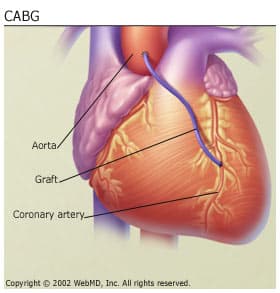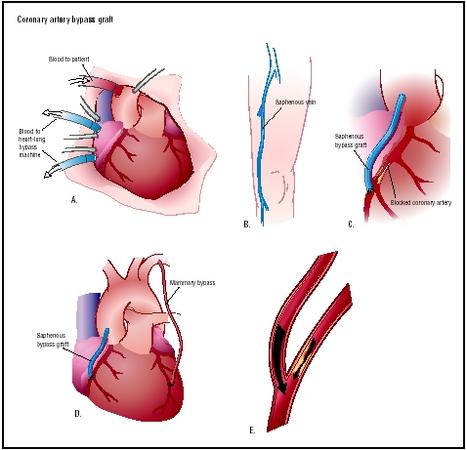Coronary artery bypass surgery
The coronary artery bypass is a blood vessel bridge, which is to ensure by -pass (English bypass ) a narrowing or occlusion of a coronary artery blood flow to the downstream vessel segment.
History
The first coronary artery bypass surgery was performed on May 2, 1960 at Albert Einstein College of Medicine - Bronx Municipal Hospital Center, USA, by a team led by Robert Goetz and Michael Rohman and with the help of Jordan Haller and Ronald Dee.
For the preparation of the bypass today arteries or veins are used. As previously exclusively veins were used, the term aorto - coronary artery bypass ( CABG ) was originally established in the German-speaking area. Today is the English abbreviation for CABG coronary artery bypass graft in use.
Implementation
Generally the operation is carried out for cardiac arrest ( cardioplegia ) using a heart -lung machine. The operation can also be performed without cardiopulmonary bypass on the beating heart (English " off-pump Coronary Artery Bypass", " OPCAB "). Thus, the incidence of postoperative stroke is reduced regardless of the surgical risk of a patient. Access is in each case by opening the chest through a median sternotomy. Furthermore, there are minimally invasive access routes ( minimally invasive direct coronary artery bypass, MIDCAP ) and the possibility of " totally endoscopic coronary artery bypass " ( totally endoscopic coronary artery bypass, TECAB ).
Arterial Bypass
In general, the left mammary artery ( internal thoracic artery, Eng. Internal mammary artery left, LIMA ) was used for reasons of proximity to power the left anterior descending artery (LAD, Eng. Left anterior descending artery ). Advantage is, firstly, that the vessel outlet is maintained and so only one side of the bypass has to be anastomosed, on the other hand, the longer lifetime of this bypass. Cause of the longer life besides the natural discharge of the vessel (only one anastomosis ) and the differences in the wall condition of arteries and veins. In rarer cases, especially in second surgeries, one of the two arteries supplying the hand ( radial artery ) will be used. Whether the long-term result is this better than using a venous bypass has not been established.
Venous bypass
For a venous bypass one usually uses one of the veins of the leg ( saphenous vein ), which runs from the ankle to the groin inside. This will be, as the arteria radialis in the ascending aorta bypass sewn and connected with the diseased vessel. Less commonly, a so-called Sequenzialbypass is used in which a vein is anastomosed to a first vessel, and in addition, for example, then even with a side branch.
Frequent locations for a venous bypass the right coronary artery (RCA ) and the circumflex artery ( RCX ).
Risks and Complications
A complication is the Dressler 's syndrome. An attempt to reduce the damage to the heart by ischemia in the operation is the preconditioning of the heart. But this is not of clinical practice.
Coronary artery bypass or PTCA
There is debate among experts as to whether the supply of coronary heart disease with a coronary bypass compared with the catheter-based percutaneous transluminal coronary angioplasty ( PTCA) is preferable. The current guidelines of the European Society of Cardiology to give revascularization for patients with low surgical risk and one or two affected coronary arteries without the involvement of the left main stem the recommendation, preferably to treat by means of PTCA. For all other patients, a higher grade recommendation for surgical treatment with a coronary artery bypass applies.









